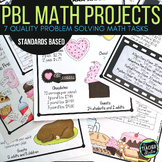Math Problem Solving Project - Bake Sale Math Task - Print and Digital
- PDF
- Google Apps™

What educators are saying
Also included in
- Are you looking for higher-level math performance tasks and problem solving activities to use with your students? This low prep, low ink AND flexible math bundle is a math problem solving resource that can be used with small enrichment groups or can be tiered so you can use it with your entire classPrice $25.00Original Price $34.65Save $9.65
Description
Are you looking for a high-level math project-based learning/problem solving project to use with your students? Finding quality math tasks that are engaging and low-prep is tough--but I've got you covered!
- Do you want flexibility—a math resource that can be used with small enrichment groups or can be tiered so you can use it with your entire class…but at different levels?
- Do you want your students to be problem solving, thinking creatively, writing and talking about math, and working collaboratively?
- Do you want them working on math in “real world” contexts?
- Do you want to have both PRINT and DIGITAL options available all in one resource?
This may be just what you are looking for!
Want to save 20% on the bundled set of these? Just CLICK HERE!
For years, I have wished and hoped for a resource that would provide my students with high quality, open ended tasks to allow them to apply what they learn to real world situations. Guess what? They are hard to find! So I thought and I thought…and finally the idea for a flexible, high level series of problems came to me.
They can be used
- whole class
- with enrichment groups
- for fast finishers
- or even in different ways with different groups of students.
This version is PERFECT for any time of year and with any group of students because it is all about planning a bake sale to raise money for an animal shelter--two very interesting and engaging ideas!
There are lots of factors to consider--this is not a fill-in-the-blank resource! This is real problem solving--where students need to make sense of problems and think deeply about solutions.
Each "Thinker Task" resource is based on a different real world theme--like planning the timing of a holiday feast, spending a day at an amusement park, or planning a party--and students need to use the "Math by the Numbers" posters (available in full color to laminate for centers and in black and white for easy copying) to work on a multiple step, open ended project.
What's Included?
- Color, black and white, and digital versions of the "Math by the Numbers" pages
- Differentiation options to help you find just the right "fit" for your class
- The real world "situation" page--where students read, make sense of the problem, and then come up with their plan to solve
- 6 additional practice pages--at two different levels. Perfect for even more problem solving! (all answers are included)
- Teaching tips
- Math talk prompts to keep your accountable talk moving
- Additional enrichment ideas for students who need even more!
The activity is tiered so that the same activity is available at different levels. Not only that, but you get additional math practice sheets (also tiered), suggestions for math discussions, extension activities, and more!
I don't think you will be disappointed--and more products in the series are on their way! This version focuses on addition and subtraction of money, reading a table, basic multiplication, and multi-step problem solving. It is ideal for grades 3 - 5 and could be used in other grade levels at your discretion. I hope you enjoy it--and the flexibility it offers you.
------------------------------------------------------------------------------------------------------
Looking for more Thinker Task resources? Here is the complete list!
Back to School Shopping Problem
A Valentine Celebration Problem
------------------------------------------------------------------------------------------------------
All rights reserved by ©The Teacher Studio. Purchase of this resource entitles the purchaser the right to reproduce the pages in limited quantities for single classroom use only. Duplication for an entire school, an entire school system, or commercial purposes is strictly forbidden without written permission from the author at fourthgradestudio@gmail.com. Additional licenses are available at a reduced price.






